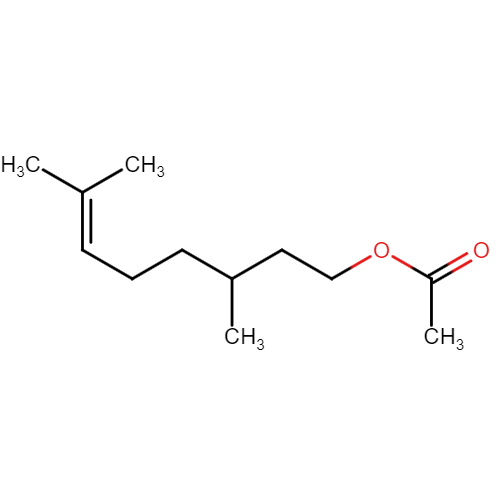Citronellyl acetate
| Compound Structure: |

|
||||||||||||||||||||||||||||||||||||||||||||||
|---|---|---|---|---|---|---|---|---|---|---|---|---|---|---|---|---|---|---|---|---|---|---|---|---|---|---|---|---|---|---|---|---|---|---|---|---|---|---|---|---|---|---|---|---|---|---|---|
| Synonyms: | Citronellyl acetate;150-84-5;Citronellol acetate;3,7-Dimethyloct-6-en-1-yl acetate;Acetic acid, citronellyl ester;1-Acetoxy-3,7-dimethyloct-6-ene;3,7-dimethyloct-6-enyl acetate;Citronellyl ethanoate;3,7-Dimethyl-6-octen-1-ol acetate | ||||||||||||||||||||||||||||||||||||||||||||||
| Compound ID: | NMPC-480 | ||||||||||||||||||||||||||||||||||||||||||||||
| PubChem ID: | |||||||||||||||||||||||||||||||||||||||||||||||
| Molecular Formula: | C12H22O2 | ||||||||||||||||||||||||||||||||||||||||||||||
| Canonical SMILES: | CC(CCC=C(C)C)CCOC(=O)C | ||||||||||||||||||||||||||||||||||||||||||||||
| InChIKey: | JOZKFWLRHCDGJA-UHFFFAOYSA-N | ||||||||||||||||||||||||||||||||||||||||||||||
| About the compound: | Citronellol acetate, also referred to as citronellyl acetate, is a fragrance industry staple renowned for its ability to add a fruity essence to an array of aromas, especially those designed to evoke the scent of rose, muguet, and lavender. It emanates a floral, rosy, and green fruity scent and is found naturally in the essential oils of citronella, geranium, and May rose absolutes. The production of citronellol acetate involves the esterification of citronellol with acetic acid or acetic anhydride within an acidic setting, or it can be produced from 3,7-dimethylocta-1,6-diene through the pyrolysis of alpha-pinene. This process includes several steps, such as the Markovnikov-type addition, Kharasch's anti-Markovnikov reaction, followed by acetylation[1]. Citronellol, from which citronellol acetate is derived, is a monoterpene alcohol discovered in the essential oil of various plants. These plants are not only utilized in culinary practices but also in traditional medicinal applications. Citronellol is recognized for its pharmacological benefits, including its antibacterial, antifungal, analgesic, and anticonvulsant properties, underscoring its utility in developing treatments for human health[2]. Additionally, the transformation of citronellal, a compound closely related to citronellol, into isopulegol and menthol via catalytic methods has been the subject of research, reflecting a broad interest in these substances. Such studies demonstrate their chemical adaptability and the potential they hold for the generation of diverse and valuable products[3]. Reference 1. ScenTree SAS. "Acétate de Citronellyle (N° CAS 150-84-5)." ScenTree. A detailed description of citronellol acetate, its chemical properties, natural occurrence, synthesis methods, and applications in perfumery. https://www.scentree.co/fr/Ac%C3%A9tate_de_Citronellyle.html. 2. Santos, P., Matos, J.P.S.C.F., Picot, L., Almeida, J.R.G.S., Quintans, J.S.S., Quintans-Junior, L.J. "Citronellol, a monoterpene alcohol with promising pharmacological activities - A systematic review." Archive ouverte HAL. This review summarizes the pharmacological activities attributed to Citronellol, highlighting its potential in treatments for humans. https://hal.science/hal-01956154. 3. Cortés, C.B., Galván, V.T., Pedro, S.S., García, T.V. "Heterogeneous Catalytic Conversion of Citronellal into Isopulegol and Menthol: Literature Review." Science and Technology Indonesia. This literature review discusses the conversion of citronellal to isopulegol and menthol, showcasing the interest in citronellal and its derivatives for chemical synthesis. GHS Hazard Statements • H315 (100%): Causes skin irritation [Warning Skin corrosion/irritation] • H319 (14.7%): Causes serious eye irritation [Warning Serious eye damage/eye irritation] • H411 (97.57%): Toxic to aquatic life with long lasting effects [Hazardous to the aquatic environment, long-term hazard] |
||||||||||||||||||||||||||||||||||||||||||||||
| Properties: |
Chemical and Physical Properties
Source:
PubChem |
||||||||||||||||||||||||||||||||||||||||||||||
| Source Species: |
Acanthus montanus Eucalyptus maculata Hyparrhenia rufa |